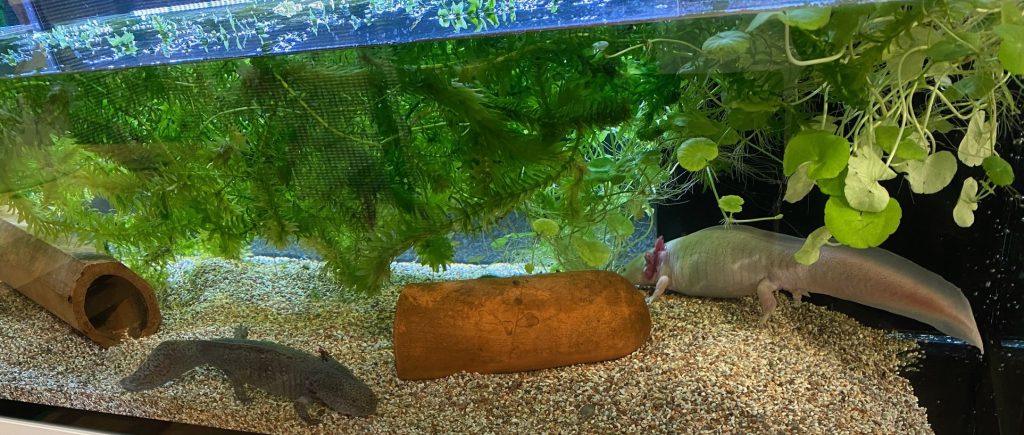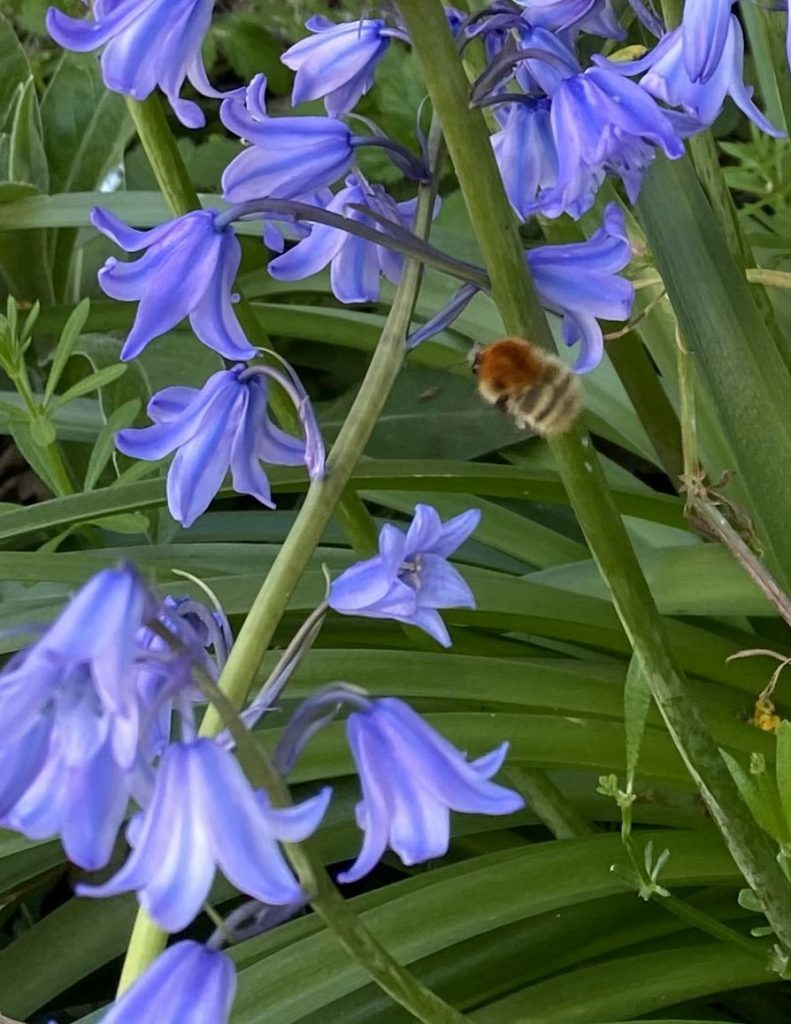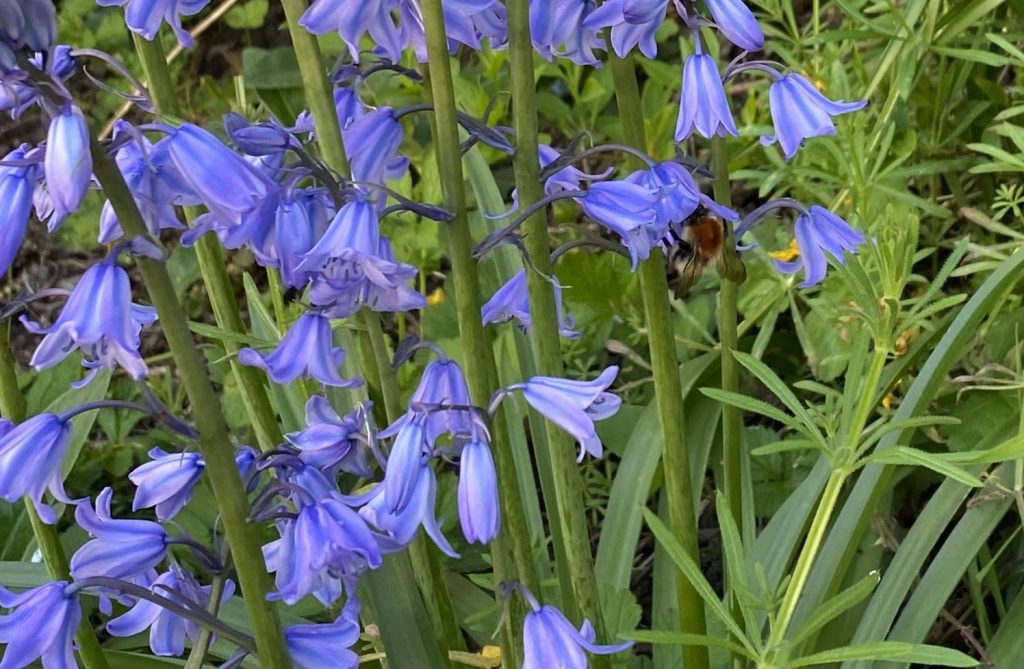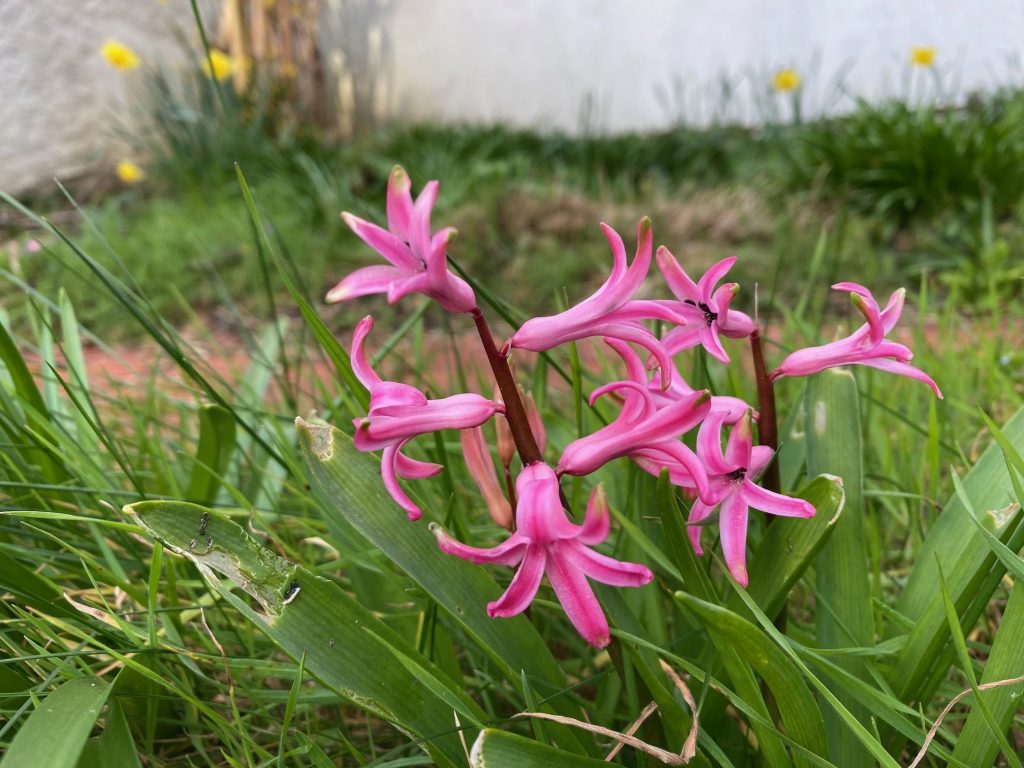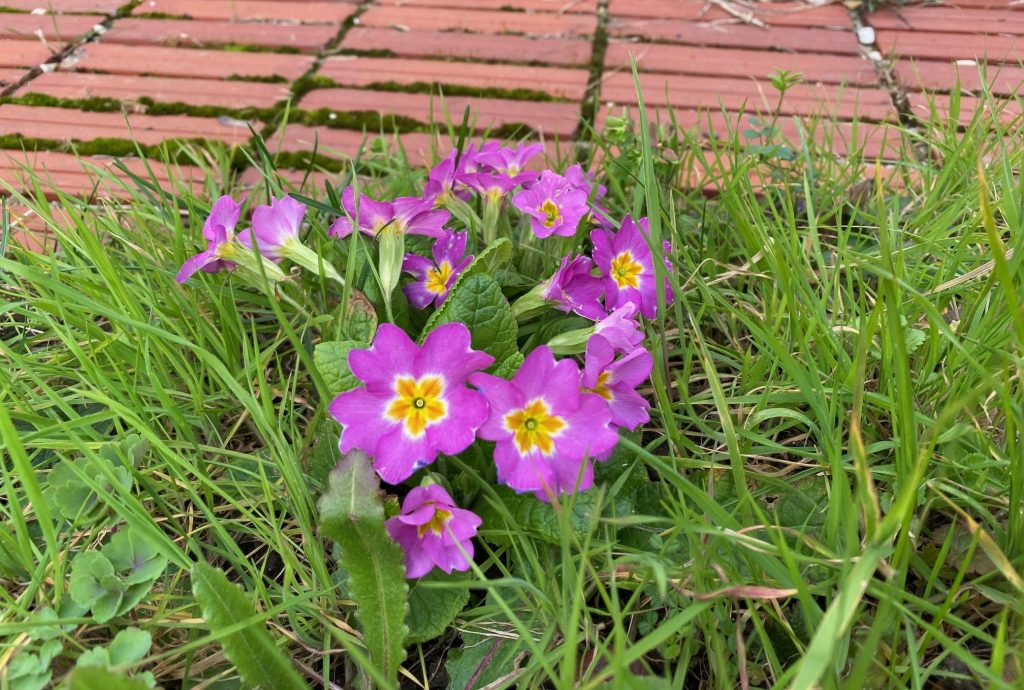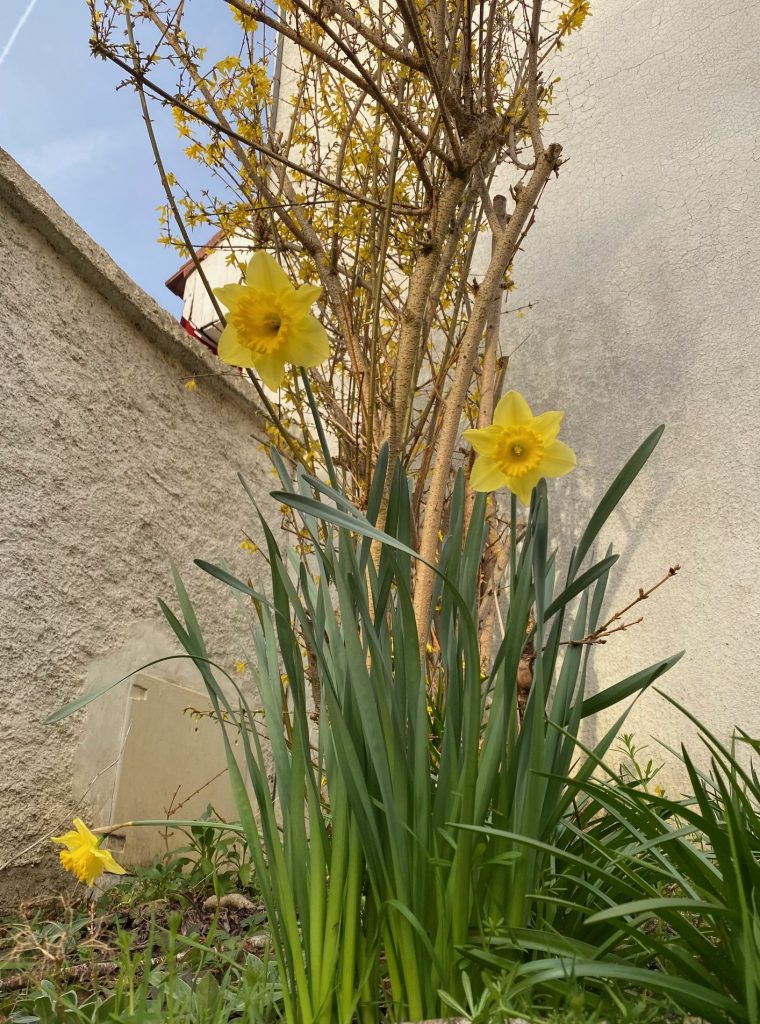Wissenschaffende, wie Kunstschaffende, haben ihre Modelle. Meistens sind es abstrakte Gedankengebilde, gerne noch mit schönen mathematischen Formeln verziert. Prototypen haben ihren eigenen Charme. Forschung über das Altern hat es da nicht so leicht seine ästhetischen Modelle auszustellen. Dabei macht uns die Natur einiges vor, wie das geht. Neben dem Axolotl sind Würmer mit nachwachsenden Gliedmaßen vielversprechende Ansätze der Erneuerung im Alternsprozess. Jedes Frühjahr ist die alte Eiche eine inspirierende Quelle der Anpassungsfähigkeit. Hitze, Klimawandel, saurer Regen und Pilze hat sie jahrhundertelang bewältigt. Jedes Frühjahr freuen wir uns über die Zeichen von Vitalität und grüner Pracht. Wiedermal Schädlinge nach Trockenheit abgewehrt und Resilienz bewiesen. Wir möchten es nicht gerne hören. Sie wird uns wohl überleben, dank ihrer Kraft der Ruhe. 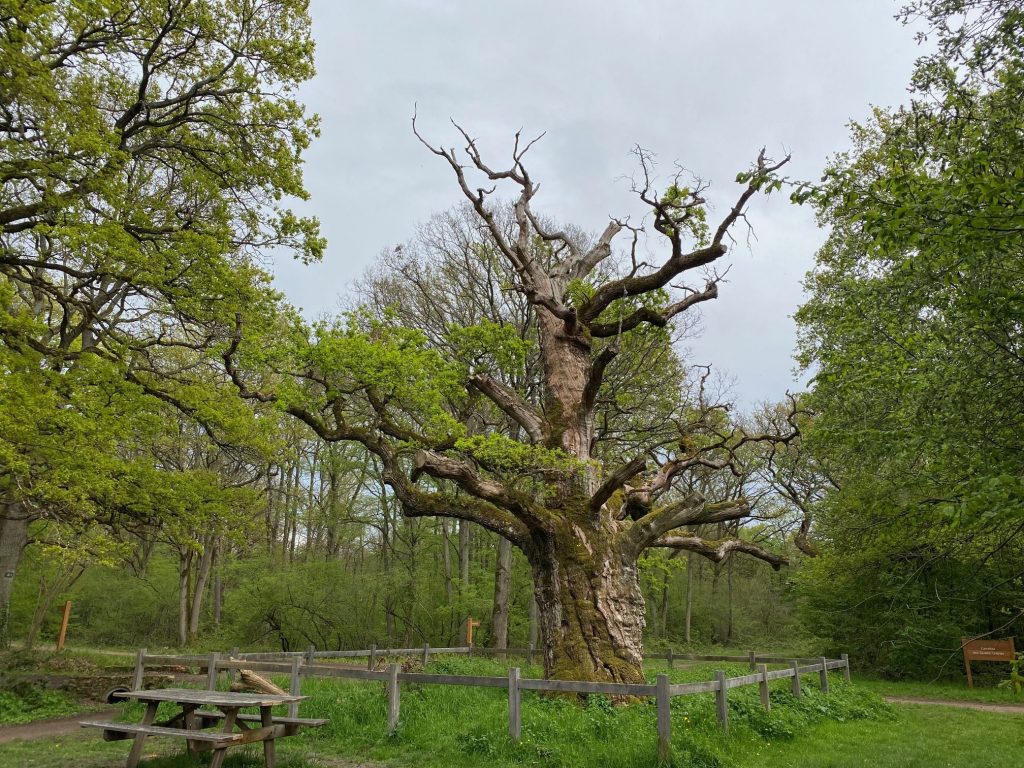
Biene
Die Tulpen haben dieses Jahr wieder alles gegeben. Die lange Trockenheit im März und der ersten Hälte vom April hat die Tulpen lange blühen lassen. Zwei kräftige Aprilschauer haben der intensiven Blüte ein Ende gesetzt. Eine große Träne bleibt noch auf den Blättern. Jetzt sind schon die Bienen, noch mit Mäntelchen, aktiv und bestäuben recht fleißig die anderen Blüten. Wir freuen uns dann schon einmal auf die nächste Tulpenblüte im Garten in 2024.
Musée quai Branly
“Musée du quai Branly – Jacques Chirac” receives relatively few visitors compared to the much more popular art museums in Paris. The proximity to the Eiffel tower, however, allows easy access within walking reach from the most visited tourist attractions in Paris. A cheeky impression of the design of the building and surrounding gardens of the Museum resemble to me a shadow of the Eiffel tower in the afternoon sun in Paris. Some might even say with a westerly wind the tower would fall exactly on the museum. No, of course the tower is not tumbling. In the shadow of the tower there is superb place to meditate in the gardens or enjoy the many exhibitions of cultures from across the world. 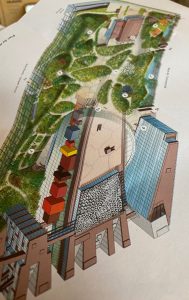 In remembrance of former President Jacques Chirac, Asian cultures have had a strong impact on the collections and the organisation of the garden. Very different from the French park “à la Le Notre” at Versailles or Fontainebleau, the garden of the museum du quai Branly follows a completely different design focusing on bio-diversity. The architect “Jean Nouvel”, is quoted having said, that the garden is not a complement to the museum, but the garden is the museum. Hence, it is possible to have very unexpected views not only from the museum buildings, but also of the Eiffel tower nearby. It is possible to view the Eiffel tower through different continental perspectives on it. To the extent that you might not even recognize the massive tower in the neighbourhood being immersed into wild life. Then try one of the special expositions or the permanent exhibition, if visiting for the 1st time. We travelled continents without devastating CO2 effects. Additionally, Paris is easy to reach by train. You may complement the intercontinental experience by visiting the headquarters of UNESCO, at least the book shop, in Paris also nearby.
In remembrance of former President Jacques Chirac, Asian cultures have had a strong impact on the collections and the organisation of the garden. Very different from the French park “à la Le Notre” at Versailles or Fontainebleau, the garden of the museum du quai Branly follows a completely different design focusing on bio-diversity. The architect “Jean Nouvel”, is quoted having said, that the garden is not a complement to the museum, but the garden is the museum. Hence, it is possible to have very unexpected views not only from the museum buildings, but also of the Eiffel tower nearby. It is possible to view the Eiffel tower through different continental perspectives on it. To the extent that you might not even recognize the massive tower in the neighbourhood being immersed into wild life. Then try one of the special expositions or the permanent exhibition, if visiting for the 1st time. We travelled continents without devastating CO2 effects. Additionally, Paris is easy to reach by train. You may complement the intercontinental experience by visiting the headquarters of UNESCO, at least the book shop, in Paris also nearby. 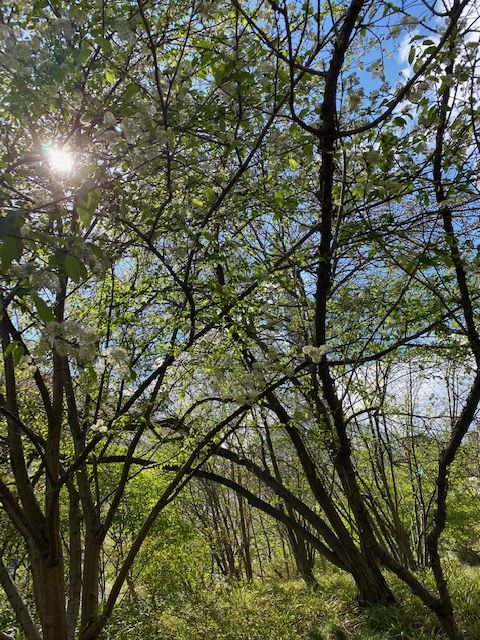
Quercus
“Quercus petraea” is the classification name of the sessile oak, the Irish Oak or “chêne sessile” in French, “Eiche” in German. Many European nations cherish their oak trees. It can reach the size bigger than a normal family home and they may live longer than the person who has planted it. Within less than a century, due to industrialisation, most of our more than a century old trees have been lost or used for timber wood. Therefore, it is quite unique to find a reference to a 500 year old oak tree nearby Paris. Despite a fire in this forest 5 years ago (climate change in full action) the old oak tree has survived. Birds around keep spreading the message that it is worth to preserve nature. We could do it, if we really wanted. Now the oak tree older than the protestant revolution is a rare testimony of the stubbornness of nature to resist. 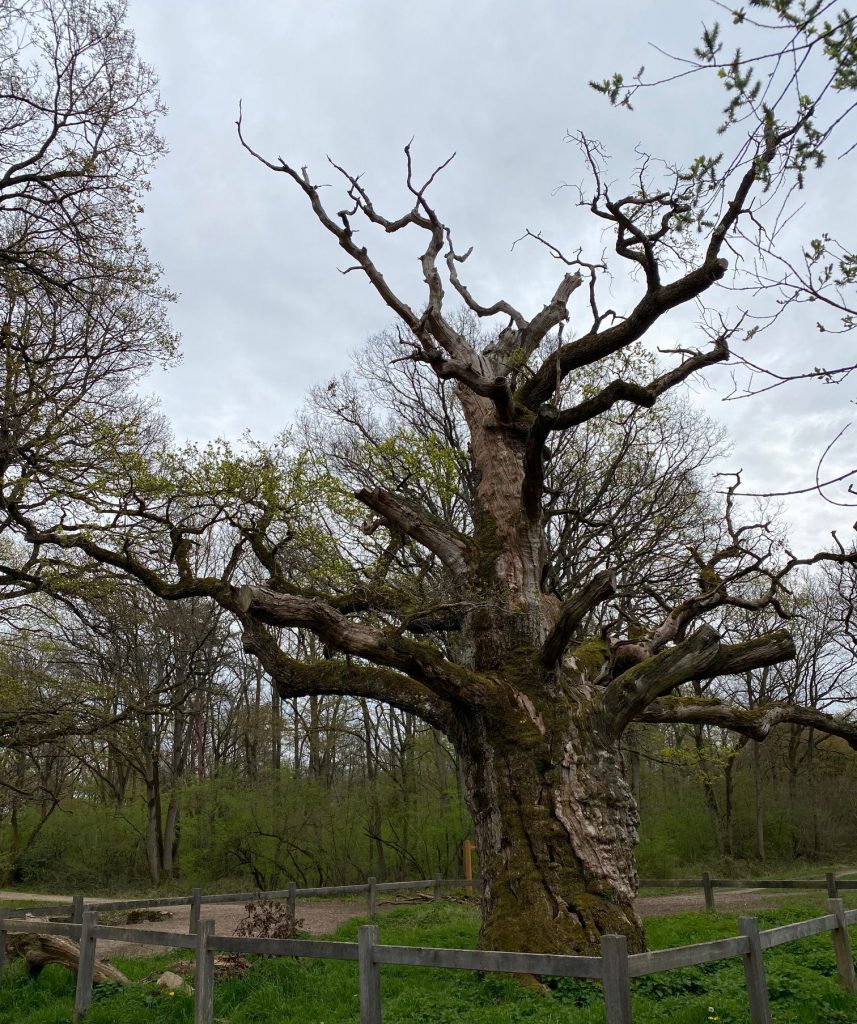

Walk
Spring is the ideal time to start walking more than in the past 6 months. Flowers all around and sunshine invite to go outside. It is so good for our health. Our mobile phones count steps for us so it is easy to reach targets you set yourself. No pressure just fun. Chose a nice surrounding, city or landscape, and the benefits will accumulate rapidly. Improving sleep afterwards is just one of the many side effects. No excuse on the long Easter weekend with bank holidays as well. Anyway, that is what I do. For our health every stride counts in the short run and even more so in the long run. Hence, let’s go. Take a few photos to look at afterwards as your special self-made reward. Cheers and Happy Easter or seasonal greetings. 

Spring2023
Spring has sprung, a little bit early in 2023. On the 16th of March in the vicinity of Paris, where Caillebotte designed his impressionist garden. It is still 4 weeks until Easter. The spring flowers will hardly survive until then. Hence, we prepare for an early summer, nice because of less heating, but the vegetation is suffering in the region due to the lack of rain. Hay fever for millions of persons will start early this year as well. The damages from a fire in the nearby forest “Sénart” from 2018 have still not really disappeared. It is expensive and needs a lot of workers, equipment and knowhow to avoid the same old mistakes of planting mono-cultures of trees again. When will they ever learn, when will they ever learn.
R for Repairing
Without noticing for many people, we have shifted into the repair mode. Our planet needs repair work. Well beyond the less plastic, CO2, less oil, gaz and pollution in general, we have to actively repair what we have damaged, certainly since the industrial revolution. With nuclear waste we have entered into a phase, in which repairing is not really feasible. Areas around Tschernobyl and Fukushima speak for themselves. However, we seem to leave the repairing to future generations. Whereas for us currently it is an option, later on it will be an obligation.
The bionic interest has already turned to the Axolotl and Polycarpa mytiligera. Both species can repair themselves after the loss or a malfunctioning part of their body. Rather than producing externally, growing the spare part is a promising healing device. Nature provides many fabulous insights, if we were able to preserve the biodiversity. Repairing biodiversity is difficult, impossible for lost species which we do not even really know. Start to repair and build awareness that repairing can be fun. Beyond the gender stereotypes, women repair cars, men repair clothes, we have to learn from each other how to use our repair knowledge for many other things and devices. This applies even to our social, legal and economic systems.
In addition to reimagining, we need repairing everywhere. I have lots of stuff to repair at home. When do you start repairing? Welcome to the next trend: the joy to repair, repairs even joy. 